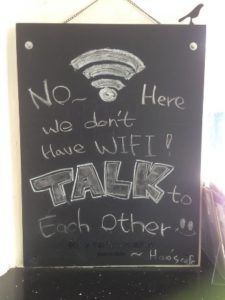Exploring digital tools that support collaboration and communication allowed me to think critically about the tools I researched for our group project, while also considering those of my classmates. In looking at my own level of understanding with navigating technology and considering some of the challenges I have encountered this term, it seems fitting that I am reflecting on using technology to support collaboration and communication.
Digital tools as we have explored over this course, enhance a student’s overall learning experience and provide opportunities to communicate, collaborate and demonstrate understandings in a variety of ways. While we explored several digital tools and platforms it seemed obvious that tech should bridge and support communication, however with a heavy reliance on it I learned sadly some of the limitations of living in a remote community with limited wifi.

“No Wifi @ Hoa’s cafe” by Dushan and Miae is licensed under CC BY-SA 2.0
My thoughts during the project:
I thought not having explored any digital tools that create videos, digital stories or websites, this might be a good place to start. While I was not confident with a lot of technology, I was pleasantly surprised and pleased with my selection of the two tools I explored.
Both Adobe Spark and ShowMe Whiteboard Interactive were interesting tools which I could definitely see using with students of all learning styles and abilities. Through the process of exploring, experimenting and “playing” with many of these digital tools, I often reflected on how these applications could be used to support students with exceptional learning needs.
My teaching background is rooted in Special Education and so I can’t help but explore this project through a Special Education lens. While I did see using both applications with many students, I only selected Adobe Spark to pursue further for the project, ShowMe Whiteboard ended up in the section “Paths not Taken” due to its over simplicity, lack of features and limitations on creativity.
I tried to create a short video with slides and voice over on critical thinking using ShowMe and thought of how frustrating it was in terms of recording. Any mistake while recording would mean that you would have to record your entire presentation from the beginning all the way through. I thought this would pose as an unnecessary challenge and frustration, especially when there are so many other user-friendly applications out there. It also made me think more about the inquiry process, how we are encouraging students to explore and be creative. The overall features of ShowMe were very limiting even in terms of formatting (not being able to centering text and images). This tool was not going to work.
My reflections afterwards:
The group project which focused on exploring digital tools to support student inquiry, allowed us to trial and evaluate several digital tools, while also working through the inquiry process ourselves. While we researched applications, gathered data, compared digital tools, we could easily see which tools would best meet the needs of our students. In addition, this project allowed us to dig further in exploring and playing with digital tools, that we may otherwise not have had the chance to explore. I also feel that despite the fact that inquiry was primarily our focus, I could definitely see using these applications for many other curricular outcomes.
Through this evaluative process we had to employ many of the BC Digital Literacies that we explored.
- Communication and Collaboration- Students use digital media and environment to communicate and work collaboratively, at a distance, supporting individual learning and contributing to the learning of others.
I saw myself and my classmates working together and demonstrating our own digital literacies by communicating with one another over multiple platforms, despite the initial tech difficulties I experienced. (I enjoyed exploring Slack, Google docs to communicate via a process journal, Zoom, Blue jeans and Google Meet).
- Critical/Reflective Thinking-Students learn to engage in inquiry when they identify and investigate questions, challenges, key issues, or problematic situations in their studies, lives, and communities and in the media.
I focused on thinking about how these digital tools could be used for all students, including those with exceptional learning needs, thought about how we could create greater access to curriculum by using these tools as well as thought about the advantages and challenges of many of the digital tools I explored. In addition, I was able to think more critically about the bigger picture, trying to piece together how these digital tools and the overall process of exploring these applications for the sake of inquiry would help me, or not in my final master’s project.
Additionally, I questioned:
- In what ways can these digital tools create greater access for students with learning difficulties?
- What can my district or school do to bridge the gap when it comes to making curriculum accessible through technology for all students?
- What is the end goal? And how can I use this process to support my overall journey in this program
I have found overall this process to be very helpful in terms of synthesizing ideas and thinking more about my final project moving forward.
- Critical Thinking and Problem Solving-Students use critical thinking skills to plan and conduct research, manage projects, solve problems, and make informed decisions using appropriate digital tools and resources.
Experimenting with digital tools, and determining which would work for the project and those that didn’t make the cut was helpful and it was nice to have the time explore different platforms. While there were lots of things to consider I think overall, we selected digital tools that would support students with thinking critically and allow them to demonstrating their understanding, ideas and create solutions to posed problems in their inquiry.
Questions I still have:
- How will I create more opportunities in my teaching practice to explore additional digital tools to use in the classroom?
There is a really great website which looks at 15 specific questions to consider when asking about Tech Integration, created by Drew Perkins, Director of TeachThoughtPD. It can be found at the link below.
https://www.teachthought.com/technology/using-technology-can/
Additional thoughts to explore with regards to access:
- How do I provide students with opportunities for collaboration while at home?
- Working from home on projects- what is this going to look like?
- How do I support students to create opportunities to make real world connections through collaborating with community members?
- Think about creative ways to provide opportunities for feedback
Final thoughts:
While I spent a lot of time worried about creating a final product, I have reflected on my overall experiences and enjoyed collaborating with Cheryl and Heather. The overall presentation has given me lots of consider moving forward with my larger project and has left me with lots to consider and explore in my professional development moving forward.
Couros, A., & Hildebrandt, K. (2016). Designing for open and social learning. In G. Veletsianos (Ed.), Emergence and innovation in digital learning: Foundations and applications. Edmonton, Canada: AU Press. Retrieved from: http://www.aupress.ca/index.php/books/120258
Government of British Columbia. Department of Education. (2013). BC’s Digital Literacy Framework. Retrieved from https://www2.gov.bc.ca/assets/gov/education/kindergarten-to-grade-12/teach/teaching-tools/digital-literacy-framework.pdf
Moore, E. (2018). Technology Can Address Digital Accessibility — to an Extent. Inside Higher Ed. Retrieved from www.insidehighered.com/digital-learning/article/2018/05/02/technology-can-help-address-accessibility-challenges-many-say


Recent Comments